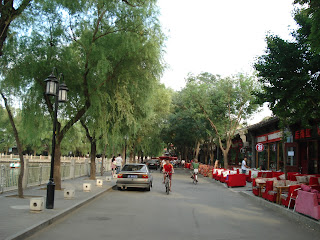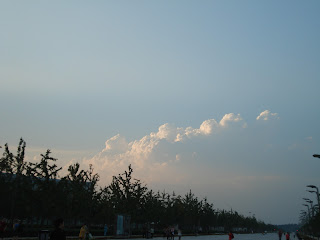It has been sometime since my last blog. Kind a forget how to write, how to blog. Luckily my busyness never let me forget to visit my blog daily. It has been a year since my last days in Beijing. However, my memories towards Beijing city are still as fresh as it was just yesterday. Today, I am going to introduce more about Beijing’s Lakes – XiHai (西海), HouHai (后海) and QianHai (前海).
ShiChaHai
Lake Scene
After my mother fully satisfied with her admiration on the Xu BeiHong’s paintings and works, we moved our step from XinJieKou North Street into an unknown alley. After not long of walking, a very nice view of lake appears in front of us. My mother got surprised that such an unknown backdoor alley is actually linked to such a nice lake.
The Small Alley
Lake Scene
Lake Scene
This historic scenic area is called the ShiChaHai (什刹海). It was called the Riverbank (河沿) during the emperor ruling period and is located to the north-west of the Forbidden City. It consists of three lakes, the Xihai, the Houhai and the Qianhai.
Lake Scene
Tree combined with the rail
Lake Scene
Shichahai is a famous scenic area in the Beijing. These beautiful lakes are surrounded by big trees and some trees are really old that they are already combined with the rail at side of the lake. It is a leisure place to walk, jog, cycling, watching ducks swimming, tours with tricycle and there are also activities like boat peddling and electric-boat boating during summer. According to online information, you can even ice-skating on top of the lake surface in winter time.
Lake Scene
Boating
The tricycle
The Shichahai area used to be one of the important commercial districts. There are ten temples around the lake; this is how Shichahai got its name. Around the lake, there are also formal royal mansions and garden, and formal residences of some famous personages. The most well-known spot are the Price Gong Mansion (恭亲王府), Prince Chun Mansion (醇亲王府), formal residence of Soong ChingLing (宋庆龄故居), and the formal residence of Guo MoRuo (郭沫若故居).
Duck swimming and playing
Taichi
Lake Scene
Xihai is the lake first appears in front of us. There are duck swimming and playing on the water. There are people who doing the “blowing sugar” art called the ChuiTangRen (吹糖人). There are places to practice Taichi (太极拳) around the lake.
Lake Scene
ChuiTangRen Artist
My Little Sugar Cow
We walked along the side of the lake from Xihai all the way down to Qianhai. On the way, I bought the sugar cow made by the “Chui-tang-ren” men. However, this little sugar cow cannot even stay with until back to the hotel; it melted due to the hot weather. We passed by the famous bridge, YinDingQiao (银锭桥) on the way to dinner place.
YinDingQiao
YinDingGuanShan (银锭观山)
Bars Street
KaoRouJi
Around the lakes, besides the historic mansion and temples, there are also a lot of bars and famous old-timer restaurants along the HouHaiBeiYan, HouHaiNanYan, YanDaiXie Street (烟袋斜街), QianHaiDongYan, QianHaiBeiYan, and basically all the street along these lakes. We had our dinner in one of the famous restaurant – KaoRouJi (烤肉季).
Barbeque Lamb
Roasted duck meat slices
Roasted duck set
In Kaorouji, we ordered their famous dish, the barbeque lamb, and a roasted duck. This is still so far the nicest Peking Duck that I have had. Well, it is of cause not comparable to the one I had in KL or Australia Chinatown.
Sources, onion and cucumber
Roasted-duck-bone soup
The big rock - Shichahai
It is almost dark after the dinner. We continued our journey along the Qianhaibeiyan and the QianHaiXiYan towards the Tian’anmen West Street. There is a big rock there with Shichahai crafted on it. Here, there are a lot of tourists around taking photo and the night view of Qianhaixiyan is very beautiful.
The big rock - Shichahai
The Plague – LiangHuaShiChang (莲花市场)
The Price Gong Mansion
Before going back to our hotel, we took a walk to the Price Gong Mansion. Due to tight schedule, we never enter to the mansion, but just take a photo of the front door as remembrance. On the way, we passed by the formal residence of Guo MoRuo. We were so tired that day, really lot of walking. The scenes are so beautiful that we were not even feeling tired while walking.
The formal residence of Guo MoRuo
Reference Map:


























































